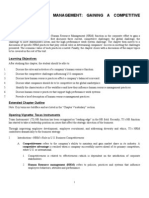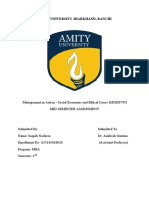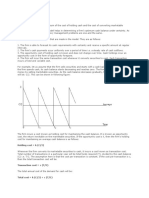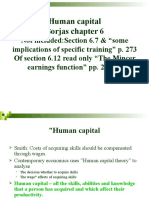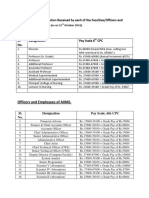Absenteeism and Labour Turnover
Absenteeism and Labour Turnover
Uploaded by
himanshirawatCopyright:
Available Formats
Absenteeism and Labour Turnover
Absenteeism and Labour Turnover
Uploaded by
himanshirawatCopyright
Available Formats
Share this document
Did you find this document useful?
Is this content inappropriate?
Copyright:
Available Formats
Absenteeism and Labour Turnover
Absenteeism and Labour Turnover
Uploaded by
himanshirawatCopyright:
Available Formats
ABSENTISM ,LABOUR
TURNOVER
AND ITS CALCULATION
ABSENTEEISM
MEANING OF ABSENTEEISM
Employees to be present in work place as per
timings or schedule fixed for the purpose .
Deviation from the fixed time reporting: Co.s
loss
When an employee fails to report for duty on
time without prior intimation or approval, then
the employee is marked as absent.
TYPES OF ABSENTEEISM
Absenteeism is of four types:
1. Authorised Absenteeism
2. Unauthorised Absenteeism
3. Wilful Absenteeism
4. Absenteeism caused by circumstances
beyond ones control
FEATURES OF ABSENTEEISM
Rate of absenteeism
The lowest --pay day
Increases -- on the days following the payment
of wages and bonus.
Generally high among the workers
Below25 years of age
Above 55 years of age.
Rate of absenteeism varies from department
to department within an organization.
Absenteeism in traditional industries is
seasonal in character
CALCULATION OF
ABSENTEEISM RATE
Absenteeism can be calculated with the help of the
following formula:
1. Absenteeism Rate
2. Frequency Rate
3. Severity Rate
CALCULATION OF
ABSENTEEISM RATE
Absenteeism Rate
Number of man days lost * 100
No. of man days scheduled to work
Frequency Rate
Total number of times in which the leave was
availed * 100
Total number of man days scheduled to
work
Severity Rate
Total number of days absent during a period *
100
Total number of times absent during the period
CAUSES OF ABSENTEEISM
Personal Factors
Work Environment
Home Conditions
Regional Aspects
Organizational Features
Social Reasons
CAUSES OF ABSENTEEISM
Personal Factors - age, marital status, health, education, hobbies,
extra curricular activities.
Work Environment working conditions, relation with
coworkers & seniors and their attitude
Home Conditions distance from residence, mode of conveyance,
family size, family problems & responsibilities
Regional Aspects legislations, politics, geographical situations
Organizational Features type & size of company, work load,
nature of work, shift arrangements, management attitude,
personnel policies, leave facilities and medical benefits
Social Reasons religion, community obligations, customs
festivals, marriage and death
SOME MEASURES TO MINIMISE
ABSENTEEISM
Selecting the employees by testing them
thoroughly regarding their aspirations, value
systems, responsibility and sensitiveness
Adopting a humanistic approach in dealing with
the personal problems of employees
Following a proactive approach in identifying and
redressing employee grievances
Providing hygiene working conditions, welfare
measures, fair and competitive remunerations,
training and development
LABOUR TURNOVER
MEANING OF LABOUR TURNOVER
Turnover means change. A change in the financial
status of an organization is called the financial
turnover. A change in the number of employees of an
organization is called The labour turnover
CAUSES OF LABOUR
TURNOVER
Reduced quality of work
Discontinuance of business
Changed Industrial process
Seasonal fluctuations in relation to volume of
business
Industrial depression
Nature of work
CAUSES OF LABOUR
TURNOVER (Contd.)
Low wages
Poor working conditions
Less opportunities for advancement
Bad relations of workers with the management also
cause labour turnover.
Union base activities of the workers create conflict
with the management
Personal problems of employees
Change of jobs----different industry
COSTS OF LABOUR
TURNOVER
High rates of labour turnover are expensive in
terms of:
Additional recruitment costs
Lost production costs
Increased costs of training replacement employees
Loss of know-how and customer goodwill
Potential loss of sales (e.g. if there is high turnover
amongst the sales force)
Damage that may be done to morale and
productivity (an intangible cost)
ESTIMATING LTO
Every good organization prepares a report of labor turnover to refer and rectify the
avoidable causes of turnover.
Average No. = (No. of employees at start + No. of employees at end) / 2
1- Separation Method/Rate:
Number of employees separated in a period * 100
Average number of employees in the period
2- Replacement Method/Rate:
Number of employees replaced in a period * 100
Average number of employees in the period
3- Flux Method/ Rate:
No. of employees separated + No. of employees replaced * 100
Average number of employees in the period
MEASURES TO CONTROL LABOUR
TURNOVER
Analysis of the employees records &identification
of dissatisfied categories of employees by the
manager
Identification of the factors or sources influencing
turnover
Exit interviews
Separation of controllable factors from
uncontrollable factors
Provision of factory policies, procedures &
practices
Action plan to remove influencing factors
Conclusion
Absenteeism and labour turnover are connected
Absenteeism above 5 % very serious
Bad reputation of business leading to drop in
sales, lower profits, bad cash flow
Decrease in output
Drop in Market share
Struggle to compete with rival companies
Reduce absenteeism and labour turnover
Introduction of incentive plans
100% attendance awards / benefits
Friendly and healthy formal relationship within the
organisations
Involvement of employees in decision making
THANK YOU
You might also like
- The Dissertation Journey A Practical and Comprehensive Guide To Planning PDFDocument6 pagesThe Dissertation Journey A Practical and Comprehensive Guide To Planning PDFPayToWritePaperUKNo ratings yet
- Case Study MBADocument13 pagesCase Study MBAAlly Coralde100% (2)
- Offer LetterDocument6 pagesOffer Lettersai krishnaNo ratings yet
- Organisation Development Assignment 1Document6 pagesOrganisation Development Assignment 1Nikita Arora100% (1)
- Managing Absenteeism - SlidesDocument17 pagesManaging Absenteeism - SlidesselvavishnuNo ratings yet
- HRM - CHPT 1 - Gaining A Competitive AdvantageDocument9 pagesHRM - CHPT 1 - Gaining A Competitive AdvantageKrishna TejaNo ratings yet
- 4 - Labour-Turnover-Absenteeism & EVPDocument17 pages4 - Labour-Turnover-Absenteeism & EVPdsravani50% (2)
- Internship Format Mba HRM - LatestDocument3 pagesInternship Format Mba HRM - LatestSadia ShahzadiNo ratings yet
- Career Development IhrmDocument5 pagesCareer Development IhrmKshipra GargNo ratings yet
- HRD and Organizational ChangeDocument10 pagesHRD and Organizational ChangeYaso TharNo ratings yet
- Organisational Change and DevelopmentDocument102 pagesOrganisational Change and DevelopmentKNOWLEDGE CREATORSNo ratings yet
- Assignment On Environmental Threat Opportunity Profile (ETOP)Document8 pagesAssignment On Environmental Threat Opportunity Profile (ETOP)ShubhamNo ratings yet
- A Study On Employee Welfare Measures in BhelDocument19 pagesA Study On Employee Welfare Measures in BhelLovely ashwinNo ratings yet
- Assignment: Organizational Behaviour - IiDocument6 pagesAssignment: Organizational Behaviour - IiJabin shihabNo ratings yet
- Case OBDocument4 pagesCase OBSoumya Ranjan SwainNo ratings yet
- HR Analytics - Unit 4 Chapter - 7 - Data Driven HR AnalyticsDocument15 pagesHR Analytics - Unit 4 Chapter - 7 - Data Driven HR AnalyticsAkshay VkNo ratings yet
- Organizational Diagnosis: Current and Desired Performance and How It Can Achieve Its GoalsDocument3 pagesOrganizational Diagnosis: Current and Desired Performance and How It Can Achieve Its GoalstalakayutubNo ratings yet
- FINANCIAL STRATEGY Formulation of Financial Strategy - Module: 1Document28 pagesFINANCIAL STRATEGY Formulation of Financial Strategy - Module: 1arul kumar100% (1)
- BCG Matrix: Using The Tool: Dr. Dheeraj NimDocument12 pagesBCG Matrix: Using The Tool: Dr. Dheeraj NimRubi Ragini kumariNo ratings yet
- Creativity in Oral CommunicationDocument5 pagesCreativity in Oral CommunicationSahil100% (1)
- Nature of Business EnvironmentDocument26 pagesNature of Business EnvironmentPallavi JainNo ratings yet
- Assessing HR Programmes:: UNIT-06 Creating HR ScorecardDocument9 pagesAssessing HR Programmes:: UNIT-06 Creating HR ScorecardAppu SpecialNo ratings yet
- Performance Management And: Reward System at Scottrade IncDocument13 pagesPerformance Management And: Reward System at Scottrade IncBarun SinghNo ratings yet
- Apple'S Healthkit: Upgrading To Stay CompetitiveDocument8 pagesApple'S Healthkit: Upgrading To Stay CompetitiveSaahi SeenivasanNo ratings yet
- Factors Affecting Talent Acquisition ManagementDocument2 pagesFactors Affecting Talent Acquisition ManagementVikas Kumar RoyNo ratings yet
- Guidance On Writing The HRM Assignment PDFDocument4 pagesGuidance On Writing The HRM Assignment PDFPritom KunduNo ratings yet
- Unit 3Document64 pagesUnit 3Senthil JS0% (1)
- Organisational EffectivenessDocument18 pagesOrganisational Effectivenessvinayaksajan100% (1)
- BBA 5th IRLL Complete Notes Updated1Document163 pagesBBA 5th IRLL Complete Notes Updated1Ûpär WáläNo ratings yet
- Q What Is Buying MotivesDocument1 pageQ What Is Buying MotivesRonsai editzNo ratings yet
- Unit-1 MHR-106 Cultural VariablesDocument28 pagesUnit-1 MHR-106 Cultural Variableskekhusezo100% (1)
- Methods To Initiate Ventures From Idea To ActionDocument2 pagesMethods To Initiate Ventures From Idea To ActionEC Virtual DeskNo ratings yet
- Od InterventionDocument8 pagesOd Interventionperkin kothariNo ratings yet
- 3 Sem SyllabusDocument6 pages3 Sem SyllabusRichard CarolNo ratings yet
- Organizational Change & Development V1Document12 pagesOrganizational Change & Development V1solvedcareNo ratings yet
- Module - 5 Employment CommunicationDocument23 pagesModule - 5 Employment CommunicationHarsha MathadNo ratings yet
- Management in Action - Social Economic and Ethical Issues (MGMT705)Document5 pagesManagement in Action - Social Economic and Ethical Issues (MGMT705)Aman KumarNo ratings yet
- SM ICICI Change Management FreeDocument36 pagesSM ICICI Change Management FreeHimanshu Oza100% (1)
- Role and Responsibility of Training ManagerDocument9 pagesRole and Responsibility of Training ManagerbekaluNo ratings yet
- Employee Empowerment and Interpersonal Interventions: An Experiential Approach To Organization Development 8 EditionDocument69 pagesEmployee Empowerment and Interpersonal Interventions: An Experiential Approach To Organization Development 8 EditionjocaNo ratings yet
- BRM Unit 3: Measurement & DataDocument46 pagesBRM Unit 3: Measurement & DataAmol KareNo ratings yet
- HR Worker's ParticipationDocument51 pagesHR Worker's ParticipationnikjaisNo ratings yet
- March Semester 2014 Bmet5103 - Entrepreneurship Assignment (60%) Individual AssignmentDocument2 pagesMarch Semester 2014 Bmet5103 - Entrepreneurship Assignment (60%) Individual AssignmentscopistarNo ratings yet
- Synopsis 00Document8 pagesSynopsis 00shalini TripathiNo ratings yet
- Effectiveness of Internal CommunicationDocument32 pagesEffectiveness of Internal CommunicationkamrunnassaNo ratings yet
- Management Studies MbaDocument5 pagesManagement Studies MbaktpshettyNo ratings yet
- Syllabus Bolton UniversityDocument5 pagesSyllabus Bolton UniversityPhuongChiNo ratings yet
- Department at I OnDocument28 pagesDepartment at I Onmikhil.muraliNo ratings yet
- India's Mega Online Education Hub For Class 9-12 Students, Engineers, Managers, Lawyers and DoctorsDocument41 pagesIndia's Mega Online Education Hub For Class 9-12 Students, Engineers, Managers, Lawyers and DoctorsDivyashree100% (5)
- MBA ToyotaDocument18 pagesMBA ToyotaMilagre MacandjaNo ratings yet
- 10 Steps in Strategy FormulationDocument3 pages10 Steps in Strategy Formulationdummy12345No ratings yet
- BPSM Notes of Unit 1Document6 pagesBPSM Notes of Unit 1Arpita DevNo ratings yet
- Managing Cultural Diversity - Implications For Organizational CompetitivenessDocument13 pagesManaging Cultural Diversity - Implications For Organizational CompetitivenessShabanaSaleem100% (3)
- Unit IV DSSDocument13 pagesUnit IV DSSArun MishraNo ratings yet
- Organizational Behavior ZZZZZZZZZZZDocument2 pagesOrganizational Behavior ZZZZZZZZZZZSyed Sajjad AliNo ratings yet
- BaumolDocument9 pagesBaumolJoshua Capa FrondaNo ratings yet
- Chapter 4 Sreekanth BPRDocument9 pagesChapter 4 Sreekanth BPRRam KrishnanNo ratings yet
- Marketing Information System A Complete Guide - 2020 EditionFrom EverandMarketing Information System A Complete Guide - 2020 EditionNo ratings yet
- HR - 22 - Leave Travel Allowance PolicyDocument6 pagesHR - 22 - Leave Travel Allowance PolicyVipin SinghNo ratings yet
- HBO Chapter 1Document21 pagesHBO Chapter 1Leon Milan Emmanuel Romano100% (1)
- Form No 16 (By Sagar Goyal)Document3 pagesForm No 16 (By Sagar Goyal)sagarNo ratings yet
- Position Paper Salcedo Et Al AntiqueDocument12 pagesPosition Paper Salcedo Et Al AntiqueHersie BundaNo ratings yet
- Human Capital Borjas Chapter 6Document45 pagesHuman Capital Borjas Chapter 6Elsa Rila OktaviantiNo ratings yet
- Sports CafeDocument140 pagesSports CafeGlaze Ann VillabesaNo ratings yet
- VASS 2016-17 Superintendent PayDocument36 pagesVASS 2016-17 Superintendent PayWSETNo ratings yet
- 2024 Employee Wellness Industry Trends Report Key TakeawaysDocument15 pages2024 Employee Wellness Industry Trends Report Key Takeawayscubero85No ratings yet
- Jurnal Keperawatan PDFDocument20 pagesJurnal Keperawatan PDFimeldaNo ratings yet
- Indonesian Labour Law Guide 2015Document45 pagesIndonesian Labour Law Guide 2015galihwahyupradanaNo ratings yet
- MHRM 1Document7 pagesMHRM 1Venkat KNo ratings yet
- IGLT Labor Law and Social Legislation Reviewer 2014Document9 pagesIGLT Labor Law and Social Legislation Reviewer 2014Iris TorrenteNo ratings yet
- Remuneration of Officers and Employees - CorrectDocument8 pagesRemuneration of Officers and Employees - CorrectVivek PrabhakarNo ratings yet
- Best Practices in Employer BrandingDocument12 pagesBest Practices in Employer BrandingcheryldsouzaNo ratings yet
- Chapter 19Document59 pagesChapter 19mas_999No ratings yet
- Personnel Handbook v1 3 20151229Document13 pagesPersonnel Handbook v1 3 20151229api-298047733No ratings yet
- AMK Ready For BindDocument36 pagesAMK Ready For BindMurali Krishna ReddyNo ratings yet
- District Regional Sales Manager in Charlotte NC Resume John WarnerDocument3 pagesDistrict Regional Sales Manager in Charlotte NC Resume John WarnerJohn WarnerNo ratings yet
- Mayon Hotel V AdanaDocument2 pagesMayon Hotel V AdanaMark Adrian ArellanoNo ratings yet
- The Maternity Benefits Act, PresentationDocument31 pagesThe Maternity Benefits Act, PresentationRicha MishraNo ratings yet
- Matriks KompetensiDocument3 pagesMatriks KompetensiMuhsan SetiyonoNo ratings yet
- DaclesDocument22 pagesDaclesJenniferPizarrasCadiz-CarullaNo ratings yet
- 1507205298QUARDENT1MODULE21Document11 pages1507205298QUARDENT1MODULE21SivaNo ratings yet
- Khan v. Office of The OmbudsmanDocument12 pagesKhan v. Office of The OmbudsmanSeok Gyeong KangNo ratings yet
- Nift MFM Mock Test (MAT) 1Document14 pagesNift MFM Mock Test (MAT) 1BlacksheepResources88% (17)
- Sree Shalini Project ReportDocument93 pagesSree Shalini Project ReportSURESH SNo ratings yet





